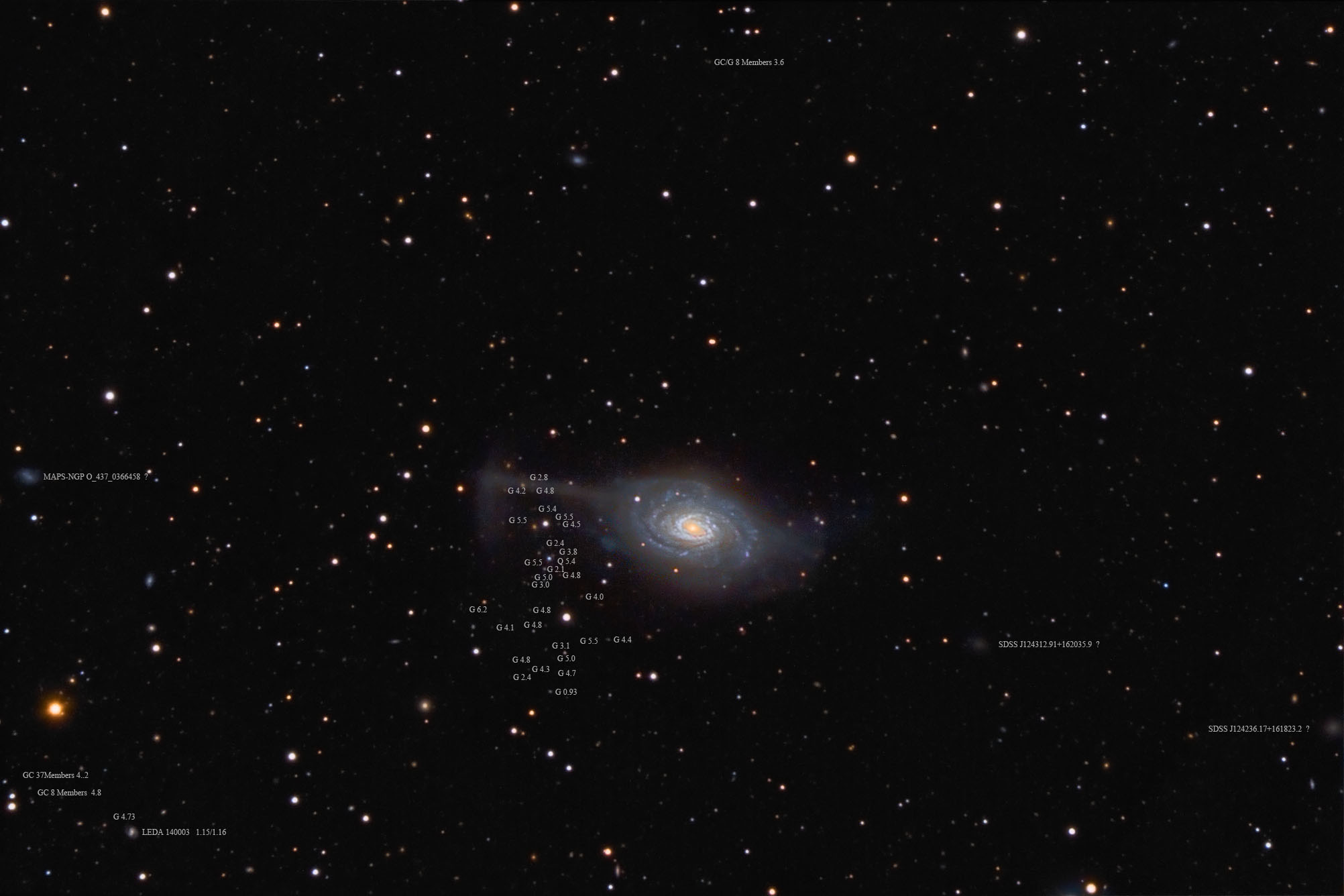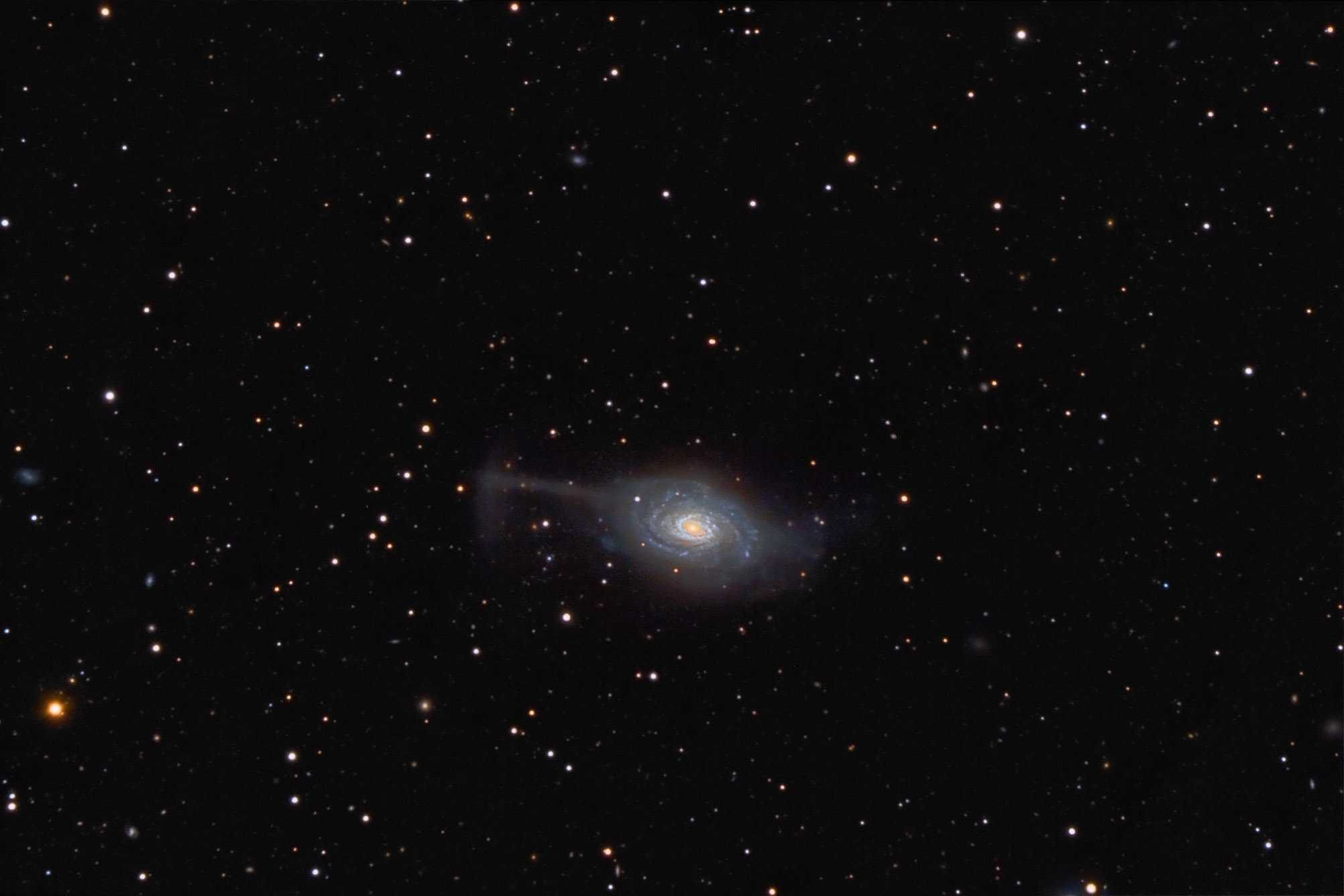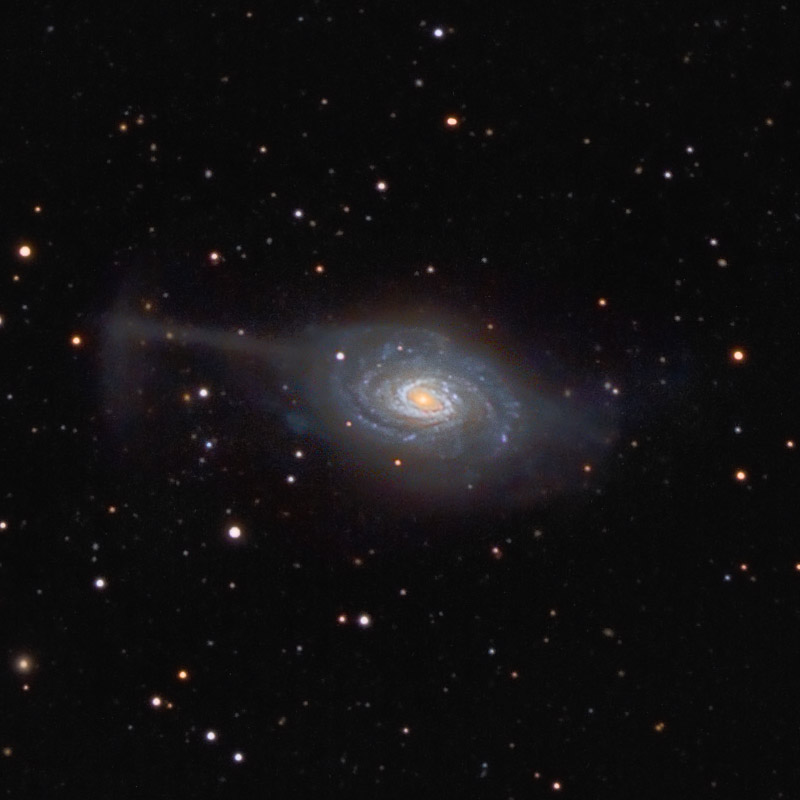Object name: ARP189 Arp 189/NGC 4651, the Umbrella Galaxy, is a member of the Virgo Cluster of galaxies in the constellation of Coma Berenices. As such it is about 60 million light-years distant. So I'm a bit perplexed with its coverage by NASA's Astronomical Picture of the Day entry for it. They say it is 35 million light-years distant. Its redshift distance is about 51 million light-years while NED lists many distance measurements by Tully-Fisher averaging about 85 million light-years and a Sosies measurement of 77 million light-years. Nothing that I found agrees to APOD's 35 million light-year distance. In other words, does anyone really know its distance?
Arp put it in his category of galaxies with narrow filaments. His comment reads: "Radio source near tail apparently not associated." We now know that its odd structure is due to it eating another galaxy in the recent past. The "narrow filament" is the remains of the galaxy showing its path around the galaxy as it was torn apart by gravitational tidal forces. NGC 4651 was discovered by William Herschel on December 30, 1783. I was somewhat surprised to find it isn't in either of the Herschel 400 observing programs.
I prepared an annotated image as there were some very distant galaxies on the east side of Arp 189. Probably on the other sides as well but for some reason, the Sloan survey only took redshift data mostly in a very small area of my image. All of it on very distant galaxies and one quasar. The quasar is closer than many of the galaxies! While my image is poor in focus it did go deep anyway with galaxies down to 23rd magnitude recorded. You may need to blow up the image to find some of these very faint ones. When you do you will find the field jammed with tiny faint fuzzy spots. I had thought this just background noise but when I looked up the position of these 22nd magnitude and fainter galaxies at 5 and even 6 billion light-years there was one of these fuzzy blobs dead on the position. Most agreed to a few hundredths of a second of arc. If off by more than the error circle of the SDSS data I skipped it. Only happened once. In one 10" circle that I tested there were 5 and every one had an entry in the catalog though only 1 had redshift data. Thus, I'm quite sure these faint blobs (blow up the image 3x or more to see them) are distant galaxies.
One galaxy with redshift data and out of the concentrated area is LEDA 140003 in the lower left corner. NED gives it two entries with no indication that they are duplicates. Both are listed in the 18th magnitude range with positions less than 1 second of arc (less than one pixel) different. The redshifts were slightly different as well. I've listed both on the annotated image. There does appear to be a second bright area that is below the core by three seconds of arc, far more than the separation NED shows and in the wrong direction. Both are listed with a position error circle of 1.25" of arc, more than the difference. But this doesn't explain the difference in the radial velocity measurement.
I've listed a few of the brighter galaxies that had no redshift data by catalog name. This is followed by a question mark as the distances are completely unknown.
Arp's image:
http://ned.ipac.caltech.edu/level5/Arp/Figures/big_arp189.jpeg
APOD image deeper than any of the above or mine with overlay of the path of the doomed satellite galaxy:
http://apod.nasa.gov/apod/ap100415.html
14" LX200R @ f/10, L=16x10' RB=6x10' G=5x10', STL-11000XM, Paramount ME Related Designation(s):2MASS J12434265+1623359, 2MASX J12434262+1623362, 2MASXi J1243426+162336, AKARI J1243429+162337, ARP 189, ARP189, BMW-HRI J124342.7+162340, CGCG 100-004, CGCG 1241.3+1640, EVCC 1102, FAUST 3414, FAUST V172, GALEXASC J124342.60+162337.7 , HDCE 0720 NED194, HIPASS J1243+16, IRAS 12412+1639, IRAS F12412+1640, ISOSS 048, ISOSS J12437+1623, KIG 0549, LDCE 0904 NED238, LGG 289:[G93] 096, MCG +03-33-001, NGC 4651, NGC 4651:[LB2005] X01, NGC 4651:[RW2000] X-01, NSA 162318, NVSS J124342+162336, PGC 042833, SDSS J124342.64+162335.9, SSTSL2 J124342.62+162335.9, UGC 07901, Umbrella Galaxy, USGC U490 NED38, UZC J124342.7+162336, VV 056, [A96] J124343.8+162331.9, [BEC2010] HRS 246, [M98j] 174 NED203, [SLK2004] 0733, | | 

